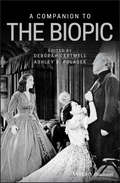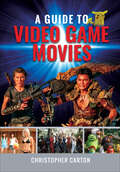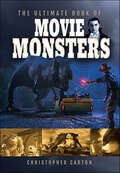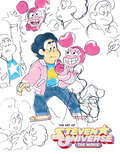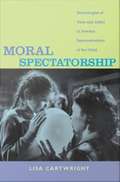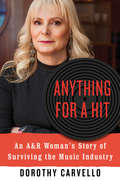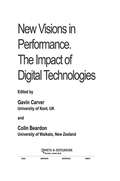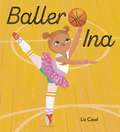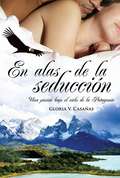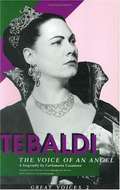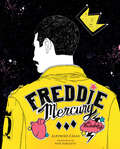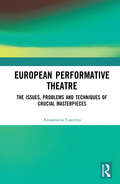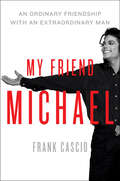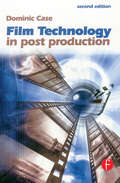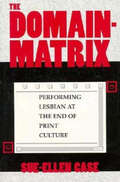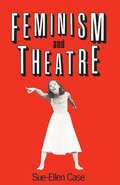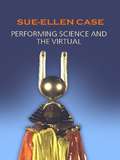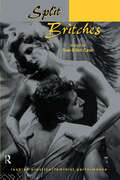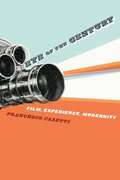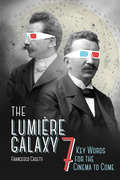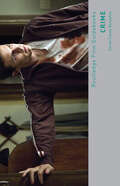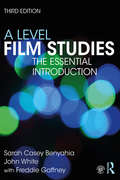- Table View
- List View
A Companion to the Biopic
by Deborah Cartmell Ashley D. PolasekThe most comprehensive reference text of theoretical and historical discourse on the biopic film The biopic, often viewed as the most reviled of all film genres, traces its origins to the early silent era over a century ago. Receiving little critical attention, biopics are regularly dismissed as superficial, formulaic, and disrespectful of history. Film critics, literary scholars and historians tend to believe that biopics should be artistic, yet accurate, true-to-life representations of their subjects. Moviegoing audiences, however, do not seem to hold similar views; biopics continue to be popular, commercially viable films. Even the genre’s most ardent detractors will admit that these films are often very watchable, particularly due to the performance of the lead actor. It is increasingly common for stars of biographical films to garner critical praise and awards, driving a growing interest in scholarship in the genre. A Companion to the Biopic is the first global and authoritative reference on the subject. Offering theoretical, historical, thematic, and performance-based approaches, this unique volume brings together the work of top scholars to discuss the coverage of the lives of authors, politicians, royalty, criminals, and pop stars through the biopic film. Chapters explore evolving attitudes and divergent perspectives on the genre with topics such as the connections between biopics and literary melodramas, the influence financial concerns have on aesthetic, social, or moral principles, the merger of historical narratives with Hollywood biographies, stereotypes and criticisms of the biopic genre, and more. This volume: Provides a systematic, in-depth analysis of the biopic and considers how the choice of historical subject reflects contemporary issues Places emphasis on films that portray race and gender issues Explores the uneven boundaries of the genre by addressing what is and is not a biopic as well as the ways in which films simultaneously embrace and defy historical authenticity Examines the distinction between reality and ‘the real’ in biographical films Offers a chronological survey of biopics from the beginning of the 20th century A Companion to the Biopic is a valuable resource for researchers, scholars, and students of history, film studies, and English literature, as well as those in disciplines that examine interpretations of historical figures
A Guide to Video Game Movies
by Christopher CartonHave you ever wondered if that game you love was made into a movie? Flip this book open and find out! Explore the fascinating journey of your favorite video games as they make their way to the silver screen! This comprehensive guide contains information on over forty big-screen adaptations of popular video games, including the histories of the series that inspired them. Covering four decades of movies, readers can learn about some of the most infamous movies in video game history, with genres such as horror, martial arts, comedy and children’s animation ensuring there’s plenty of trivia and analysis to keep gamers hooked. With nearly two-hundred full color stills, posters and screenshots, the book is a go-to guide to discovering facts about some of the biggest box office hits and the most disappointing critical bombs in history. From bizarre science fiction like Super Mario Bros. to the latest big budget releases like Monster Hunter, and dozens in between, A Guide to Video Game Movies should please film buffs and die-hard game fans alike. Whether you’re looking for rousing blockbuster action, family-friendly entertainment or a late-night B-movie to laugh at with your friends, you’re bound to find a movie to fit your taste. Put down your controller and grab your popcorn!
The Ultimate Book of Movie Monsters
by Christopher CartonDo you believe in monsters? We dare you to take a look inside this cursed tome containing some of the most iconic and obscure monsters from the history of cinema. Cower in fear of Count Dracula and his dreaded children of the night. Abandon hope as the mightiest kaiju ever seen on film decimate all around them. Pray that silhouette at the end of your bed is just a shadow and not the dreaded Babadook. Spanning nearly a century of cinematic terrors, The Ultimate Book of Movie Monsters showcases creatures from genres such as horror, fantasy, B-movies and even musicals. Along with legendary beasts like Frankenstein’s monster, Godzilla, the Living Dead and the (mostly) friendly creatures of Monsters Inc., you’ll find film facts, creature strengths and weaknesses and over 150 full-color pictures of the monsters themselves. From the era of stop-motion beasties to the cinematic showdown of the century in Godzilla vs. Kong, film lovers and horror aficionados will find plenty to keep their lust for terror satiated. But beware, for the beasts that dwell within these forsaken pages may just keep you up all night. You have been warned…
The Art of Steven Universe: The Movie
by Cartoon NetworkGo behind the scenes of Cartoon Network's highly anticipated film with this unique art book!This magical deep-dive into Steven Universe The Movie is designed by Ryan Sands (Frontier) in conjunction with Steven Universe creator Rebecca Sugar! See preliminary character designs, witness the formation of settings and storyboards, and discover the art that shaped the full-length movie! It's a new kind of artistic adventure with with Garnet, Amethyst, Pearl, and--of course--Steven.
Moral Spectatorship: Technologies of Voice and Affect in Postwar Representations of the Child
by Lisa CartwrightWhy were theories of affect, intersubjectivity, and object relations bypassed in favor of a Lacanian linguistically oriented psychoanalysis in feminist film theory in the 1980s and 1990s? In Moral Spectatorship, Lisa Cartwright rethinks the politics of spectatorship in film studies. Returning to impasses reached in late-twentieth-century psychoanalytic film theory, she focuses attention on theories of affect and object relations seldom addressed during that period. Cartwright offers a new theory of spectatorship and the human subject that takes into account intersubjective and affective relationships and technologies facilitating human agency. Seeking to expand concepts of representation beyond the visual, she develops her theory through interpretations of two contexts in which adult caregivers help bring children to voice. She considers several social-problem melodramas about deaf and nonverbal girls and young women, including Johnny Belinda, The Miracle Worker, and Children of a Lesser God. Cartwright also analyzes the controversies surrounding facilitated communication, a technological practice in which caregivers help children with communication disorders achieve "voice" through writing facilitated by computers. This practice has inspired contempt among professionals and lay people who charge that the facilitator can manipulate the child's speech. For more than two decades, film theory has been dominated by a model of identification tacitly based on the idea of feeling what the other feels or of imagining oneself to be the other. Building on the theories of affect and identification developed by Andr Green, Melanie Klein, Donald W. Winnicott, and Silvan Tomkins, Cartwright develops a model of spectatorship that takes into account and provides a way of critically analyzing the dynamics of a different kind of identification, one that is empathetic and highly intersubjective.
Anything for a Hit: An A&R Woman's Story of Surviving the Music Industry
by Dorothy CarvelloDorothy Carvello knows all about the music biz. She was the first female A&R executive at Atlantic Records, and one of the few in the room at RCA and Columbia. But before that, she was secretary to Ahmet Ertegun, Atlantic’s infamous president, who signed acts like Aretha Franklin and Led Zeppelin, negotiated distribution deals with Mick Jagger, and added Neil Young to Crosby, Stills & Nash. The stories she tells about the kingmakers of the music industry are outrageous, but it is her sinuous friendship with Ahmet that frames her narrative. He was notoriously abusive, sexually harassing Dorothy on a daily basis. Still, when he neared his end, sad and alone, Dorothy had no hatred toward him—only a strange kind of loyalty. Carvello reveals here how she flipped the script and showed Ertegun and every other man who tried to control her that a woman can be just as willing to do what it takes to get a hit. Featuring never-before-heard stories about artists like Michael Jackson, Madonna, Steven Tyler, Bon Jovi, INXS, Marc Anthony, Phil Collins, and many more, this book is a must-read for anyone who has ever wondered what it's really like to be a woman in a male-dominated industry.
New Visions In Performance: The Impact Of Digital Technologies (Innovations in Art and Design)
by Gavin Carver Colin BeardonNew Visions in Performance features the work of twelve performers and academics who are concerned with the integration of digital technologies into theatrical performance.
A Girl and Five Brave Horses
by Sonora Carver Elizabeth LandSonora Carver, when she was 16 never dreamed that she would be in show business doing an act that was amazing and exciting. But when she ran into Dr. Carver, and saw the Diving Horses act, she fell in love. Sonora had a great life traveling the country, riding and doing shows, and loving the horses she worked with. Klataw, John the Baptist, Juda, Red Lips, Snow, and Lightning, all were her family and her friends. Then one day Red Lips did a very dramatic nose dive and Sonora hit the water with her eyes open and face first. Her life changed after that day and this is her story. This book was the inspiration for the movie "Wild Hearts Can't Be Broken".
Baller Ina
by Liz CasalSwish! Sure to be a slam-dunk at storytime, this rhyming picture book introduces readers to Ina, a graceful ballerina...who also loves to get competitive on the basketball court!Doesn&’t matter what you call her.Ballerina, basketballer. On the court or at the barre,Ina is a superstar! Ina loves to dance ballet: tendu, passé, and grand jeté. But there&’s more she can do in her pink tutu! Cheer from the sidelines as Ina--with her signature ballet moves--helps lead her basketball team to victory in this picture book that celebrates the marvelously multifaceted nature of kids.
EN ALAS DE LA SEDUCCION (EBOOK)
by Gloria V. CasañasEn un rincón remoto de la Patagonia Argentina, un hombre se oculta del mundo y, sobre todo, de su pasado. Newen Cayuki, por cuyas venas corre la sangre de los bravos indios tehuelche, sabe que los dioses le han negado todo, incluido el amor. Pero no imagin nunca que la maldición tomaría la forma de una hermosa mujer blanca, ni que su encarnizada lucha contra ella acabaría en la derrota más dulce, la de la rendición por amor. Cordelia no tiene otro propósito, al llegar a ese lugar en el fin del mundo, que ayudar a su querido hermano gemelo. Llevada por su audacia, pensó que la misión sería fácil, pero no contaba con la presencia imponente de aquel bárbaro que la intimida, la repudia y parece odiarla por alguna oscura razón. Sólo la magia ancestral de los antiguos, bajo la sombra de las alas del cóndor de los Andes, podría desenredar la maraña de los sentimientos que ata los corazones.
Renata Tebaldi: The Voice of an Angel
by Carlamaria Casanova Connie De CaroAuthorized biography of one of the twentieth century's greatest operatic sopranos. Includes complete performance history and discography.
Freddie Mercury: An Illustrated Life
by Alfonso CasasA beautifully illustrated biography of the iconic lead singer of the British rock band, Queen.The music of Queen and powerhouse lead singer Freddie Mercury are best experienced with the volume turned all the way up. Alfonso Casas&’s Freddie Mercury delivers a sonorous homage to the formidable singer and the turning points that produced a game-changing body of music that continues to inspire fans around the globe.First published in Spain and now available worldwide, this luminous work covers Freddie&’s three &“births:&” his birth as Farrokh Bulsara in Zanzibar; his adoption of the last name of Mercury and the launch of Queen with Brian May and Roger Taylor; and the emergence of the lasting legend after Freddie&’s death at the age of forty-five. Casas&’s evocative illustrations highlight the key moments in the singer&’s transformation from child prodigy to superstar, bringing to life the bold innovator who broke free of his conventional upbringing. Chronicling events from Freddie&’s marriage to Mary Austin and early fame in London&’s 1970s glam scene, to the making of multiple megahits (including the six-minute chart-topper &“Bohemian Rhapsody&”), to his final years in a lasting relationship with Jim Hutton, Freddie Mercury is an exhilarating, poignant portrait of a creative genius who lived life to the hilt.&“Through Casas&’ evocative and vibrant illustrations, [Freddie Mercury] tells the story of Freddie Mercury&’s three &“births:&” from his childhood, growing up as Farrokh Bulsara in Tanzania, to Queen&’s launch to his death at 45.&” —Alcalde &“A beautifully illustrated biography of Freddie Mercury . . . Casas lovingly presents a creative take on the life of Freddie Mercury through the use of dozens of vibrant drawings.&” —OutWord Magazine &“[Freddie Mercury] is an appealingly modest book: Casas aims to let Mercury shine, but his striking illustrations shine in their own right as well.&” —The Current
European Performative Theatre: The issues, problems and techniques of crucial masterpieces
by Annamaria CascettaPerformative theatre is one of the most important trends of our time. It is emblematic of the work of many European theatrical artists in the early twenty-first century. Annamaria Cascetta does not propose a model or a historical overview, but rather strives to identify the salient features of a significant trend in the theatrical research and transformation of our time by analysing some crucial examples from outstanding works, of great international resonance. She draws on work by artists from different generations, all active between the late twentieth century and the first decades of the twenty-first, and in various European countries, performed in a number of European theatres in recent years. The aim is to apply a method of analysis in depth, bringing out the technical elements of contemporary "performative theatre" in the field, and above all to highlight the close links between it and the urgent and troubled issues and problems of history and society in the phase of cultural and anthropological transition we are experiencing.
My Friend Michael: An Ordinary Friendship with an Extraordinary Man
by Frank CascioEveryone knows Michael Jackson—the myth. This is the revealing true story of Michael Jackson—the man.To Frank Cascio, Michael Jackson was many things—second father, big brother, boss, mentor, and teacher, but most of all he was a friend. Though Cascio was just a few years old when he first met Jackson in 1984, at the peak of the pop star’s career, Jackson was at the center of his life for the next twenty-five years, allowing Cascio to observe firsthand the greatest entertainer the world had ever seen. In that time, he became the ultimate Michael Jackson insider, yet remained publicly silent about his experiences. Until now. In My Friend Michael, Cascio refutes the rumors, lies, and accusations that have accumulated over the years, providing a candid look at the Michael Jackson he knew for more than two decades. Offering an uplifting and definitive account of the legend, Cascio details how he grew up alongside Jackson, traveling the world with him on concert tours and eventually working for him. Through this lens, Cascio captures Jackson’s most private and tumultuous moments, while also setting the record straight on the entertainer’s notorious and misunderstood lifestyle—from his Peter Pan reality and his sexuality to the false allegations against him. As Cascio shows, there was a great deal more to Michael Jackson than the headlines about him have suggested. Cascio reveals his friend in all his complexity, bringing to light his passions and joys as well as his flaws and eccentricities. Including stories about Jackson that have never before been made public, Cascio creates a balanced, human look at the pop star, one that shows Jackson as the very real person he was—a lively friend with an endearingly juvenile sense of humor. What emerges is a clear-eyed yet deeply respectful portrait of Jackson—a man who was at times unremarkably average but also terribly scarred by his life in the spotlight. Packed with never-before-seen photos, anecdotes, and insights, My Friend Michael is a trove of Michael Jackson lore that both celebrates his life and redefines our understanding of the man behind the myth.
Film Technology in Post Production (Media Manuals Ser.)
by Dominic CaseAn easy to follow, quick reference introductory guide for beginning professionals and students in filmmaking and postproduction. It explains all film laboratory procedures in the context of the wide range of technology that is used by filmmakers, explaining what happens and why at every stage. A technical understanding of film processing and printing, telecine and laboratory and digital processes will help you get the best results for your film. The book is particularly useful for those who have come to film making from other media - video or digital. The book is based on the author's own experience as a lab technician and technical film consultant and provides answers to many frequently asked questions. The different pathways for film production and postproduction are demonstrated as well as the function of the lab at each stage of the process. The complete range of services is offered, with particular emphasis on the often confusing requirements for super 16 and the blow up to 35mm, the intricacies of negative cutting to match a non-linear edit and the process of grading and regrading for the answer print.This new edition includes:* An update on all digital formats of image and sound* Revision sections on Super 16, Super 35* Additional information on syncing rushes at telecine and to digital images* The latest telecine machines* A new, clear and simple glossary
The Domain-Matrix: Performing Lesbian at the End of Print Culture (Theories of Representation and Difference Ser.)
by Sue-Ellen Case"This book demonstrates Case's continued dominance of the field of lesbian performance studies.... Case's dense, rich, and complex work very likely will be a central text for anyone interested in debating the changing theoretical landscape for performance studies and queer theory. All readers interested in what the future might hold for scholarship in the humanities should study Case's thought-provoking work, which is an essential addition to any college or university's collection." --Choice"... this is a book that is enormously provocative, that will make you think and feel connected with the latest speculation on the implications of the electronic age we inhabit." --Lesbian Review of Books"... definitely required reading for any future-thinking lesbian." --Lambda Book ReportThe Domain-Matrix is about the passage from print culture to electronic screen culture and how this passage affects the reader or computer user. Sections are organized to emulate, in a printed book, the reader's experience of computer windows. Case traces the portrait of virtual identities within queer and lesbian critical practice and virtual technologies.
Feminism and Theatre
by Sue-Ellen CaseThis classic study is both an introduction to, and an overview of, the relationship between feminism and theatre.
Performing Science and the Virtual
by Sue-Ellen CaseThis impressive new book from Sue-Ellen Case looks at how science has been performed throughout history, tracing a line from nineteenth century alchemy to the twenty-first century virtual avatar. In this bold and wide-ranging book that is written using a crossbreed of styles, we encounter a glance of Edison in his laboratory, enter the soundscape of John Cage and raid tombs with Lara Croft. Case looks at the intersection of science and performance, the academic treatment of classical plays and internet-like bytes on contemporary issues and experiments where the array of performances include: electronic music Sun Ra, the jazz musician the recursive play of tape from Samuel Beckett to Pauline Oliveros Performing Science and the Virtual reviews how well these performances borrow from spiritualist notions of transcendence, as well as the social codes of race, gender and economic exchange. This book will appeal to academics and graduates studying theatre and performance studies, cultural studies and philosophy.
Split Britches: Lesbian Practice/Feminist Performance
by Sue-Ellen CaseThe Split Britches theatre company have led the way in innovative and challenging lesbian performance for the last decade. Split Britches: Lesbian Practice/Feminist Performance is a long awaited celebration of the theatre and writing of Lois Weaver, Peggy Shaw and Deborah Margolin, who make up this outstanding troupe. This unique anthology comes complete with: * seven of Split Britches' best loved performance texts * a critical, historical introduction by Sue-Ellen Case * programme notes to accompany each of the plays * a range of stunning photographic illustrations The publication of the Split Britches play texts, collected here for the first time, provides invaluable access to these celebrated performance pieces for both the student and contemporary arts audience.
Eye of the Century: Film, Experience, Modernity (Film and Culture Series)
by Francesco CasettiIs it true that film in the twentieth century experimented with vision more than any other art form? And what visions did it privilege? In this brilliant book, acclaimed film scholar Francesco Casetti situates the cinematic experience within discourses of twentieth-century modernity. He suggests that film defined a unique gaze, not only because it recorded many of the century's most important events, but also because it determined the manner in which they were received.Casetti begins by examining film's nature as a medium in an age obsessed with immediacy, nearness, and accessibility. He considers the myths and rituals cinema constructed on the screen and in the theater and how they provided new images and behaviors that responded to emerging concerns, ideas, and social orders. Film also succeeded in negotiating the different needs of modernity, comparing and uniting conflicting stimuli, providing answers in a world torn apart by conflict, and satisfying a desire for everydayness, as well as lightness, in people's lives. The ability to communicate, the power to inform, and the capacity to negotiate-these are the three factors that defined film's function and outlook and made the medium a relevant and vital art form of its time.So what kind of gaze did film create? Film cultivated a personal gaze, intimately tied to the emergence of point of view, but also able to restore the immediacy of the real; a complex gaze, in which reality and imagination were combined; a piercing gaze, achieved by machine, and yet deeply anthropomorphic; an excited gaze, rich in perceptive stimuli, but also attentive to the spectator's orientation; and an immersive gaze, which gave the impression of being inside the seen world while also maintaining a sense of distance. Each of these gazes combined two different qualities and balanced them. The result was an ever inventive synthesis that strived to bring about true compromises without ever sacrificing the complexity of contradiction. As Casetti demonstrates, film proposed a vision that, in making opposites permeable, modeled itself on an oxymoronic principle. In this sense, film is the key to reading and understanding the modern experience.
Eye of the Century: Film, Experience, Modernity
by Francesco CasettiIn this brilliant book, acclaimed film scholar Francesco Casetti examines film's nature and role in the twentieth century, an age obsessed with immediacy, worried about newness, eager for nearness and transparency, and torn apart by conflict. In its time, cinema negotiated the different needs of modernity, compared and united conflicting stimuli, and provided answers for everydayness. Film cultivated a personal gaze, intimately tied to the emergence of point of view, but also able to restore the immediacy of the real; a complex gaze, in which reality and imagination were combined; a piercing gaze, achieved by machine, and yet deeply anthropomorphic; an excited gaze, rich in perceptive stimuli, but also attentive to the spectator's orientation; and an immersive gaze, which gave the impression of being inside the seen world while also maintaining a sense of distance. Each of these gazes combined two different qualities and balanced them, resulting in a synthesis that strived to bring about true compromises without ever sacrificing the complexity of contradiction. As Casetti demonstrates, film proposed a vision that, in making opposites permeable, modeled itself on an oxymoronic principle, and is therefore the key to understanding the modern experience.
The Lumière Galaxy
by Francesco CasettiFrancesco Casetti believes new media technologies are producing an exciting new era in cinema aesthetics. Whether we experience film in the theater, on our hand-held devices, in galleries and museums, onboard and in flight, or up in the clouds in the bits we download, cinema continues to alter our habits and excite our imaginations.Casetti travels from the remote corners of film history and theory to the most surprising sites on the internet and in our cities to prove the ongoing relevance of cinema. He does away with traditional notions of canon, repetition, apparatus, and spectatorship in favor of new keywords, including expansion, relocation, assemblage, and performance. The result is an innovative understanding of cinema's place in our lives and culture, along with a critical sea-change in the study of the art. The more the nature of cinema transforms, the more it discovers its own identity, and Casetti helps readers realize the galaxy of possibilities embedded in the medium.
The Lumière Galaxy: Seven Key Words for the Cinema to Come (Film and Culture Series)
by Francesco CasettiFrancesco Casetti believes new media technologies are producing an exciting new era in cinema aesthetics. Whether we experience film in the theater, on our hand-held devices, in galleries and museums, onboard and in flight, or up in the clouds in the bits we download, cinema continues to alter our habits and excite our imaginations. Casetti travels from the remote corners of film history and theory to the most surprising sites on the internet and in our cities to prove the ongoing relevance of cinema. He does away with traditional notions of canon, repetition, apparatus, and spectatorship in favor of new keywords, including expansion, relocation, assemblage, and performance. The result is an innovative understanding of cinema's place in our lives and culture, along with a critical sea-change in the study of the art. The more the nature of cinema transforms, the more it discovers its own identity, and Casetti helps readers realize the galaxy of possibilities embedded in the medium.
Crime (Routledge Film Guidebooks)
by Sarah Casey BenyahiaCrime films have, since the earliest days of cinema, been popular with audiences, industry and critics alike and encompassed a diverse range of subjects, styles and themes. The genre provides a range of pleasures for the spectator, from taking on the role of the detective in the pursuit of clues in the ‘whodunit’, to the more illicit thrills of identification with an anti hero. In the many incarnations of the crime film such as the gangster, film noir, political and detective thrillers, the genre explores the anxieties of different historical moments. Sarah Casey Benyahia provides an overview of the development of the crime film and examines the key theories and ideas involved in the study of the genre. These include; the investigative structure and narration of the crime film, the aesthetics of violence and issues of representation and ideology. These areas are explored through contemporary and classic, Hollywood and European cinema with case studies on the history of the genre, the role of the detective, the 'family crime' film and the conspiracy thriller. Crime provides a broad framework to the study of the genre through the introduction of narrative, genre and audience theories as well as detailed analysis of specific films. Films discussed include: Scarface (1932) Mildred Pierce (1945) Dirty Harry (1971) The Parallax View (1974) Reservoir Dogs (1992) Mystic River (2002) Hidden (2005) Gone Baby Gone (2007) Zodiac (2007) The Millennium Trilogy (2009) The Secret in Their Eyes (2010)
A Level Film Studies: The Essential Introduction (Essentials)
by Sarah Casey Benyahia John White Freddie GaffneyThis essential book covers the key areas for A Level Film Studies students, building confidence through a careful, step-by-step approach. The first part of the book establishes a basic understanding of the grounding of film analysis in the various elements of film construction, mise en scène, cinematography, editing, sound and performance, developing the knowledge students have of movies whilst challenging them to consider new films and ideas. Key theoretical approaches around narrative, genre, representation, spectatorship and authorship are introduced in part two, before we consider specific national cinemas from around the world in parts three and four. In part five, the book assesses a range of slightly different film experiences, looking at silent cinema, experimental films and documentaries; before, finally, part six shifts to evaluating creative approaches to students’ own filmmaking. Specifically designed to be user-friendly, the book has an easy-to-follow design, includes more than sixty colour images and is packed with features such as: 1. case studies on a range of films and filmmakers, 2. activities on such films as Sunrise (Murnau, 1927, US), Vertigo (Hitchcock, 1958, US), Do the Right Thing (Lee, 1989, US), We Need to Talk About Kevin (Ramsay, 2011, UK), Stories We Tell (Polley, 2012, Can), 3. definitions of key terms, 4. suggestions for further reading and website resources. Matched to the current exam specification, A Level Film Studies: The Essential Introduction covers everything students need to study as part of the course. The book is supported by a companion website at www.alevelfilmstudies.co.uk offering further advice and activities.
